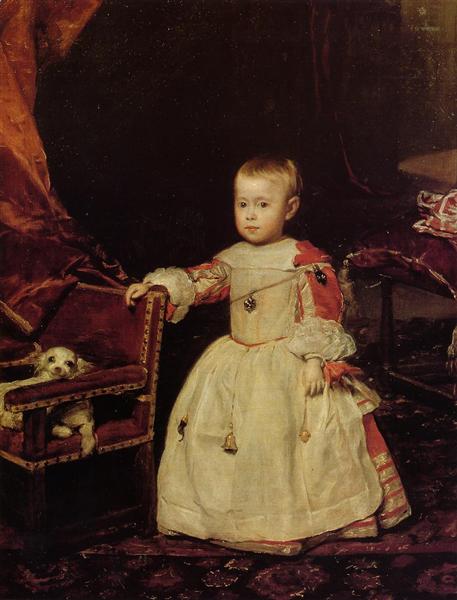Descrição
Diego Velázquez's painting "Prince Philip Prospero - Son of Philip IV", painted in 1659, is a work that encapsulates both the intimacy of portraiture and the grandeur of 17th-century Spanish royalty. In this painting, the painter, whose master technique is at the forefront of the Baroque, portrays his young model with a delicacy and sense of detail that transcends time.
The composition of the work is notable for its apparent simplicity, which highlights the central figure of the infant Philip Prospero. The prince, dressed in luxurious attire that reflects his status as the king's son, is presented with a grace that is both innocent and dignified. The choice of clothing, predominantly in white with gold embroidery that captures the light, accentuates his childlike purity and highlights the noble status conferred upon him by his lineage. This use of light and dark contrast in the background is characteristic of Velázquez's palette, who used lighting not only to give volume to the figures, but also to create an emotional environment that allows him to connect with the viewer.
The infant's face, framed by golden hair, radiates an expression of curiosity and innocence, which is especially poignant given the tragic history of the royal family. Philip Prospero, whose future was cut short at an early age by death, reflects a time when royalty was both a symbol of power and vulnerability. By portraying him in this context, Velázquez is not only documenting a ceremonial event, but also offering a glimpse into the private life of the royal family, an aspect often overlooked in the grandeur of historical depictions.
Velázquez's technique, his masterful use of oils and his ability to capture textures are evident in this work. The folds of the clothing, the sheen of the embroidery and the softness of the prince's skin are testament to his technical mastery. This approach is also reflected in other contemporary works, such as "Las Meninas", in which Velázquez employs a complex visual narrative, while also focusing his attention on the human figure and its representation.
A fascinating aspect of “Prince Philip Prospero” lies in its placement in the context of the Habsburg dynasty, whose iconography was often marked by tragedy. This simple portrait, far from being just a character study, fits into a series of depictions of child royalty that Velázquez made throughout his career, where vulnerability and fragility are intertwined with the pompous reality of the court. This conflict between figure and background, between being and seeming, is a recurring theme in the Baroque, a movement that sought not only representation, but dissertation on the human condition.
When looking at this work, one cannot help but be drawn to the delicate interplay of light and shadow that Velázquez handles almost poetically. One can also perceive an atmosphere that invites reflection on the ephemeral passage of time and the fragility of life, a sense of melancholy that permeates the painting and makes it a work of both admiration and lament.
“Prince Philip Prospero – Son of Philip IV” is, therefore, not only a portrait of a child, but a meditation on power, identity and destiny. Through Velázquez’s artistic ingenuity, the viewer is invited to delve into the complexity of Spanish courtesy, where the light of splendor and the shadow of tragedy coexist in a delicate balance. Thus, this painting becomes a testimony not only to the talent of its creator, but also to the profound narratives that art can evoke beyond the visible.
KUADROS ©, a famous painting on your wall.
Hand-made oil painting reproductions, with the quality of professional artists and the distinctive seal of KUADROS ©.
Painting reproduction service with satisfaction guarantee. If you are not completely satisfied with the replica of your painting, we will refund 100% of your money.

